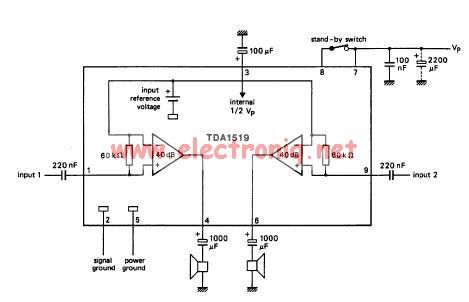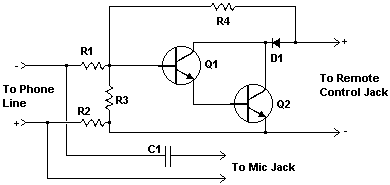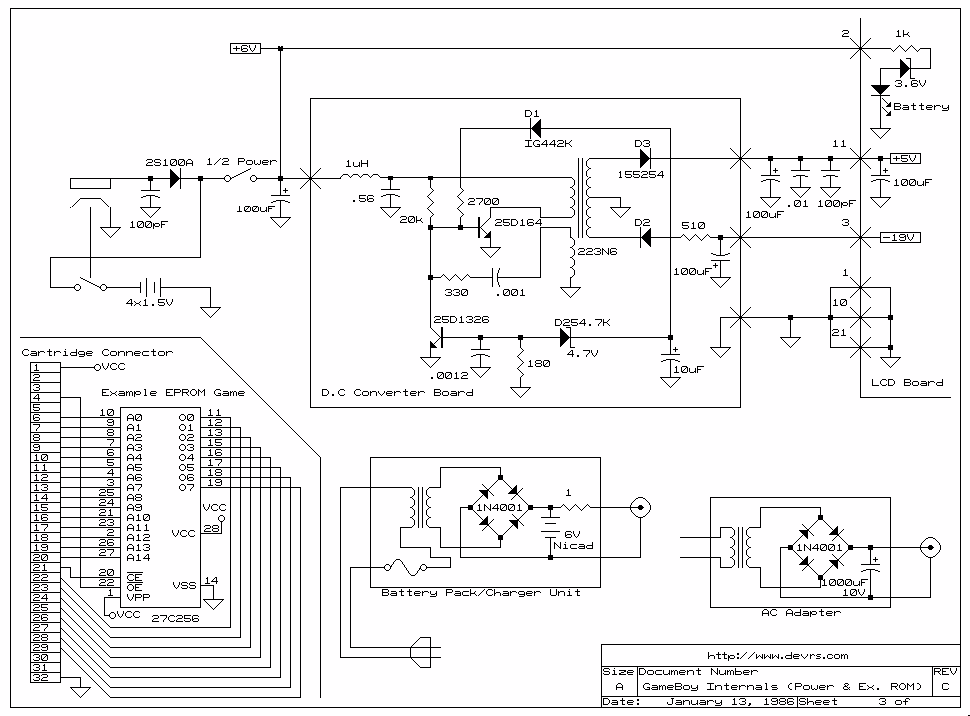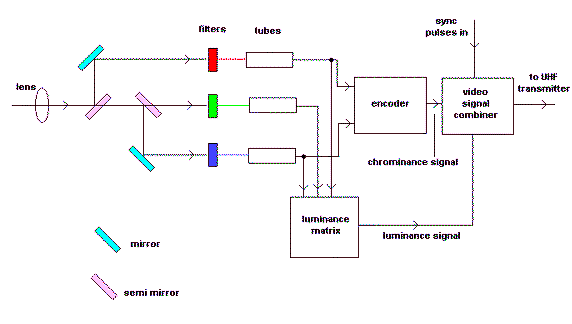
Understanding circuit diagram on datasheet and resistor value
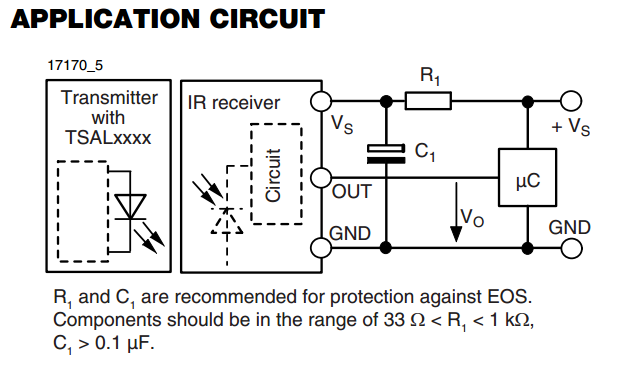
There is an interest in starting an introductory electronics project using an infrared (IR) sensor, but there is some confusion regarding the application circuit provided in the datasheet. The recommended resistor value is significantly lower than the calculated value. The datasheet specifies a supply current of 0.27 mA to 0.45 mA and a supply voltage of 2.5V to 5.5V. The intention is to operate the sensor at 0.35 mA with a 3.3V supply, which results in a required resistance of approximately 10 kΩ, much higher than the suggested range of 33 Ω to 1 kΩ. Clarification is sought on how the low resistor values specified in the datasheet can be valid when calculations indicate otherwise. Additionally, there is a query about the necessity of a decoupling capacitor in the circuit, which is understood to supply extra current during brief high current demands, especially given the low current operation (0.35 mA). There is a question about whether the capacitor can be omitted, considering the datasheet lists an absolute maximum current of 3 mA, which the circuit might attempt to draw.
In the context of electronics, the application circuit for an infrared (IR) sensor typically involves a few key components: the IR sensor itself, a resistor, and potentially a capacitor for decoupling. The resistor is crucial for limiting the current flowing through the sensor. The datasheet's recommended resistor values, which range from 33 Ω to 1 kΩ, may seem low compared to the calculated requirement of 10 kΩ when operating at 0.35 mA with a 3.3V supply. This discrepancy can arise from different operational modes of the sensor, such as its sensitivity and the specific application requirements. The low resistor values could be intended for specific configurations or to ensure that the sensor operates within its optimal range under varying conditions.
When considering the decoupling capacitor, it serves to stabilize the voltage supply by providing transient current during sudden increases in demand, which is common in digital circuits. Even in low current applications, such as one operating at 0.35 mA, including a decoupling capacitor can be beneficial. It helps to mitigate voltage fluctuations that may occur during operation, especially when the sensor is activated or when other components in the circuit draw current intermittently. Given that the absolute maximum current specified is 3 mA, it is advisable to include the capacitor to ensure reliable operation, as it can help manage unexpected current spikes and maintain stable circuit performance. The value of the capacitor can be determined based on the specific requirements of the circuit and the frequency of operation but typically ranges from a few microfarads to several microfarads.
In summary, careful consideration of the resistor values and the inclusion of a decoupling capacitor is essential for the reliable operation of the IR sensor circuit. Understanding the specifications provided in the datasheet and their implications on circuit performance is key to successfully implementing the project.Interested in starting an intro electronics project using a IR sensor and am having a little trouble understand the application circuit given on the datasheet of the circuit. The value of resistor they recommend using is far less then the one I calculate I should need. The supply current given on the datasheet is 0. 27mA - 0. 45mA and the suppl y voltage is 2. 5V - 5. 5V. I intend to run this sensor at 0. 35mA with 3. 3V and this yields a needed resistance of around 10K ohms; far greater than the 33 - 1K ohms suggested. As this is my first venture into electronics, could someone help me to understand how using such a low resistor as specified would work when the math says otherwise On a slightly related note, from what I understand, the capacitor in the circuit is called a decoupling capacitor and is used to provide the extra current during short periods of high current draw so the voltage supply does not.
Because this is such a low current circuit (or is 0. 35mA low ), is it fine if I leave the capacitor out or should I include it because the datasheet lists the absolute maximum current as 3mA and the circuit may try to draw that much 🔗 External reference
In the context of electronics, the application circuit for an infrared (IR) sensor typically involves a few key components: the IR sensor itself, a resistor, and potentially a capacitor for decoupling. The resistor is crucial for limiting the current flowing through the sensor. The datasheet's recommended resistor values, which range from 33 Ω to 1 kΩ, may seem low compared to the calculated requirement of 10 kΩ when operating at 0.35 mA with a 3.3V supply. This discrepancy can arise from different operational modes of the sensor, such as its sensitivity and the specific application requirements. The low resistor values could be intended for specific configurations or to ensure that the sensor operates within its optimal range under varying conditions.
When considering the decoupling capacitor, it serves to stabilize the voltage supply by providing transient current during sudden increases in demand, which is common in digital circuits. Even in low current applications, such as one operating at 0.35 mA, including a decoupling capacitor can be beneficial. It helps to mitigate voltage fluctuations that may occur during operation, especially when the sensor is activated or when other components in the circuit draw current intermittently. Given that the absolute maximum current specified is 3 mA, it is advisable to include the capacitor to ensure reliable operation, as it can help manage unexpected current spikes and maintain stable circuit performance. The value of the capacitor can be determined based on the specific requirements of the circuit and the frequency of operation but typically ranges from a few microfarads to several microfarads.
In summary, careful consideration of the resistor values and the inclusion of a decoupling capacitor is essential for the reliable operation of the IR sensor circuit. Understanding the specifications provided in the datasheet and their implications on circuit performance is key to successfully implementing the project.Interested in starting an intro electronics project using a IR sensor and am having a little trouble understand the application circuit given on the datasheet of the circuit. The value of resistor they recommend using is far less then the one I calculate I should need. The supply current given on the datasheet is 0. 27mA - 0. 45mA and the suppl y voltage is 2. 5V - 5. 5V. I intend to run this sensor at 0. 35mA with 3. 3V and this yields a needed resistance of around 10K ohms; far greater than the 33 - 1K ohms suggested. As this is my first venture into electronics, could someone help me to understand how using such a low resistor as specified would work when the math says otherwise On a slightly related note, from what I understand, the capacitor in the circuit is called a decoupling capacitor and is used to provide the extra current during short periods of high current draw so the voltage supply does not.
Because this is such a low current circuit (or is 0. 35mA low ), is it fine if I leave the capacitor out or should I include it because the datasheet lists the absolute maximum current as 3mA and the circuit may try to draw that much 🔗 External reference

